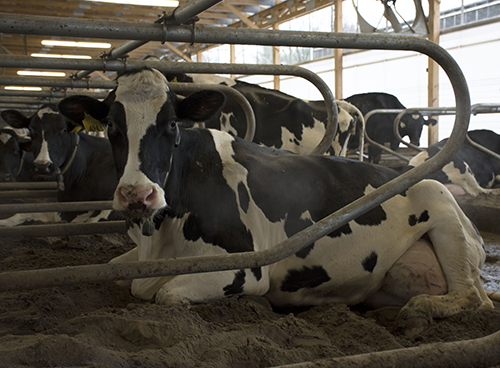
Cows are busy creatures, and one of the most important activities they do is rest.
"We want to see high-producing cows lying down 10 to 14 hours per day," said Dan McFarland from Penn State University. "I am confident with good stall design and management we can achieve this resting time on dairies."
A good stall should encourage use, provide comfort and confident footing, and promote cleanliness and udder health, McFarland noted. In a Dairy eXtension webinar, he gave producers several measurements that determine if stalls are doing their job.
Stalls can be analyzed by their physical characteristics: length, width, stall surface, neck rail placement and so on. Also, consider the time used and percent of stalls utilized. You can evaluate physical attributes of your freestall barn using this Penn State "Dairy Facility Risk Factors" scoring guide.
"Most importantly, you need to observe," McFarland said. "Observe both short term and long term to see how cows are reacting to the environment they are presented." Observation of stalls takes time, and you need to look at them several times per day, he explained.
Some cow observations that can be made to evaluate stalls are locomotion, hock lesion and hygiene scoring. You can also use the cow comfort index (number of cows lying in a stall/the number of cows touching a stall) or the stall use index (number of cows lying in a stall/the number of cows not eating).
"The indexes don't work perfectly," McFarland advised, "as cows have a cyclical behavior." For example, the number lying down is generally lowest an hour after milking because cows are eating, but we want them to be eating, he said. There is a sharp upturn between hours two and three, when cows move from the feed area to stalls.
"Don't be fooled by overstocking," he warned. Stall design and comfort may be very good, but excessive overpopulation leads to poor usage and more idle standing in the aisles.
"Cows will sacrifice eating time to make up for lost resting time," he said. They will also eat faster, which can lead to slug feeding. Overcrowding also causes greater aggression and more displacements at the feedbunk. "The subordinate cows are most affected," he said.
Research has shown a fairly significant drop in milk production once 120 percent stocking density (total cows/number of stalls, multiplied by 100) is exceeded.
Therefore, giving cows the right stalls, and enough of them, is fundamental to health and performance. Since cows can't tell you directly, you need to watch them to measure the effectiveness of your barn.
"Cows are the ultimate judge of how a stall is going to work," McFarland said.

The author is an associate editor and covers animal health, dairy housing and equipment, and nutrient management. She grew up on a dairy farm near Plymouth, Wis., and previously served as a University of Wisconsin agricultural extension agent. She received a master's degree from North Carolina State University and a bachelor's from University of Wisconsin-Madison.











